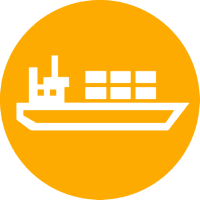EAC and Customs Union & Common Market
While the objectives of the East African Community cover almost all spheres of life, the main goal of the Customs Union is the formation of a Single Customs Territory and the implementation of the Common Market Protocol. It is within this context that internal tariffs and non-tariff barriers that could hinder trade between the Partner States have to be eliminated in order to facilitate cross-border trade through the formation of a single market and investment area. Similarly, policies relating to trade between the Partner States and other countries, such as the external tariffs, must be harmonised. Within a Customs Union, Partner States acting as a Single Customs Territory and trading bloc will be able to enjoy economies of scale, with a view to speeding up economic development and growth in the region.
The German Government supports this EAC Sector under Core Area 1 of EAC-German cooperation as defined by BMZ 2030 – “Sustainable Economic Development, Training and Employment” in the Intervention Area of “Socially and Environmentally Sound Supply Chains, Trade and Sustainable Infrastructure." The cooperation directly contributes to implementing four of the eight priority areas defined by the 6th EAC Development Strategy, namely “Customs Services that Facilitate Legitimate Trade and Investment," “Re-engineering Production and Logistics Arrangements in Line with Digitalized Frameworks," “Development of Regional Infrastructure," and “Awareness Creation." The BMZ 2030 reform strategy focuses on a new quality of cooperation. More information on BMZ 2030 can be found here.

Customs Union & Common Market
EAC-Germany Support

Standards and Customs Processes
Despite the immense opportunities offered by the EAC’s regional market, the share of intra-regional trade remains at a low of 10%, leaving 90% to external trade partners. This has been partly attributed to a lack of or failure to implement harmonised standards and customs procedures. The 6th EAC Development Strategy 2021-2026 envisions the attainment of a fully functional Customs Union through the implementation of the Single Customs Territory, enhanced ICT systems for customs administrations and other key players. Furthermore, it aims at the elimination of trade barriers, promotion of SMEs, participation in intra-regional trade and market access expansion to facilitate legitimate trade and investment in the EAC as well as safeguard government revenues. Additionally, the EAC region aspires to improve regional trade and value addition by harmonising standards for the most traded EAC products. Harmonised standards boost productivity by reducing trade costs by avoiding duplication in testing and inspection, streamlining operations and eliminating restrictive regulations.Projects:
SEAMPEC II (GIZ)
Objective: Strengthening value addition in selected priority sectors (pharma, leather, and fruits & vegetables).
Approach: SEAMPEC II contributes to improving the framework conditions for increased trade, investment and value addition by supporting the EAC to implement harmonised standards and customs procedures in selected priority sectors (pharmaceuticals, leather, fruits & vegetables). Specifically, SEAMPEC II supports the implementation of simplified customs procedures for perishable goods, awareness creation among all key stakeholders and capacity building on customs procedures. A special focus is on ensuring that the private sector’s recommendations regarding the improvement of relevant framework conditions are considered in the policy decision-making processes of the EAC and its Partner States.
This part of SEAMPEC II is implemented by GFA Consulting Group GmbH Tanzania Branch.
Find more information on SEAMPEC II here.

Trade in Services
On average, Trade in Services contributes around 59% to overall GDP in the EAC Partner States. The economic impact and contribution of services within the region cannot be overstated. Furthermore, services link to other industries. They add value to manufacturing and contribute to SME development through financial services such as mobile money. In short, services are key to the economic growth of the EAC Partner States. The free movement of services and service providers therefore further strengthens competitiveness, productivity and employment within the EAC region. The liberalisation of Trade in Services in the EAC is anchored on provisions and obligations within the Articles of the Common Market Protocol, which provide the legal basis for implementing commitments to services within the Community.Projects:
SEAMPEC II (GIZ)
Objective: Facilitation of the regional movement of EAC services and service providers through the removal of restrictions and barriers such as laws, regulations and cumbersome administrative procedures.
Approach: SEAMPEC II supports the Partner States, through the EAC Secretariat, in the development of interventions and measures that improve framework conditions through the elimination or reduction of barriers and restrictions that otherwise impede the free movement of services and service providers. These can be regulatory in nature, such as domestic laws that either discriminate against or otherwise prevent EAC service providers from accessing the respective markets, or de facto and cumbersome administrative processes that are costly and complicated.
Already-achieved milestones include:
- EAC Partner States have committed to provide Market Access and National Treatment to EAC service providers across all modes of supply in seven service sectors (Education, Distribution, Business Services, Communication, Financial, Transportation and Tourism Services).
- Development of draft regulations on the free movement of services and service suppliers.
- Increased private sector participation and engagement in Trade in Services liberalisation processes.
- Development of roadmaps for Mutual Recognition Agreements implementation.
In the context of SEAMPEC II and moving forward, EAC-Germany will support the identification and removal of Trade in Services barriers and restrictions in the priority sectors of Tourism, ICT and Business Services. This will involve the following:
- Advancement of the One Network Area to all Partner States and developing regulatory frameworks/guidelines on mobile money, data and voice call and SMS roaming in the Financial and Communication sectors with respect to the EAC Common Market Protocol.
- Development of the EAC Tourism Barometer with overall objective to support improvements in the framework conditions for data collection and to Fastrack growth of tourism services in the EAC to enable better collective decision-making and gauge the effectiveness of policies, strategies, actions and leadership as it pertains to tourism development.
- Development of minimum standards and guidelines for tour operators, travel agents and tour guides.
- Classification criteria for tourist accommodation establishments and restaurants.
- Support the EAC steering single tourist visa process with a focus on showcasing the benefits for all Partner States of having a single tourist visa.
Find more information on SEAMPEC II here.

Operationalisation of One Stop Border Posts
Fast and safe clearances at border crossing points drive the EAC integration process. One Stop Border Posts (OSBPs) introduce the concept of coordinated border management to reduce the time taken at EAC’s internal borders in pursuit of facilitating movement, integration and trade via open and safe borders. So far, the EAC has completed the construction of twelve OSBPs. In cooperation with EAC-Germany and other development partners, the EAC developed the regional OSBP curriculum and jointly trained border officers from the different border agencies of neighbouring states on how to efficiently and effectively cooperate to operate OSBPs for the goal of enabling EAC integration through coordinated border management.Projects:
GIZ-AUBP (GIZ)
Objective: The AU Member States implement conflict-preventive border governance initiatives - such as the definition of their borders and border cooperation projects - in line with the policies of the AU and RECs.
Approach: Cross-border cooperation – The project works with border communities, civil society, local and state actors to implement cross-border cooperation projects at selected borders that are close to their needs and lives.
Find more information on GIZ-AUBP here.

AFCFTA
The African Continental Free Trade Area (AfCFTA) is the Pan-African instrument to boost intra-African trade. It aims at creating a single African market by deepening the economic integration of the continent. AfCFTA will aid the movement of capital and people as well as facilitate investment, thereby moving Africa towards the establishment of a future continental Customs Union. Accelerating intra-African trade and boosting Africa's trading position in the global market by strengthening Africa's common voice and policy space in global trade negotiations is being facilitated in the EAC with the support of EAC-Germany.
Projects:
AfCFTA (GIZ)
Objective: Framework conditions for implementing the African Continental Free Trade Area are strengthened.
Approach: EAC-Germany's AfCFTA component is supporting the EAC in strengthening the EAC's preparedness in AfCFTA processes with a focus on:
- Trade in Goods – Support to EAC to conduct an analysis to identify tariff lines where EAC will grant preferential treatment and the value of EAC’s intra-Africa exports covered basing on the agreed and outstanding AfCFTA Rules of Origin.
- EAC offers – Support to EAC in finalising the tariff offers for trade in goods and positions on request and offers for their respective schedules of commitments, including conducting an analysis of the potential services export market for EAC under AfCFTA
- AfCFTA Phase II Issues – Support to EAC in their preparation for negotiations of phase II issues by commissioning scoping studies on competition, investment and intellectual property rights. Additionally, training and capacity building workshops on investment for all six EAC Partner States to enhance capacity of the Partner States experts on investment protocol negotiations
- Private Sector Engagement – Development of training tools for capacity building and awareness raising on the AfCFTA Agreement, e.g. training for capacity building and awareness raising for cross-border women traders on AfCFTA; gender workshop on AfCFTA to provide platform for EAC women to exchange on strategies to enhance women participation in the opportunities presented by the AfCFTA.
Find more information on AfCFTA here
SEAMPEC II (GIZ)
Objective: Strengthening the framework conditions for implementation the African Continental Free Trade Area.
Approach: SEAMPEC II supports the Partner States, through the EAC Secretariat, in the development of interventions and measures that improve framework conditions through development of positions and capacity building to engage further in negotiations as well as during implementation.
Progress Made: 1st January 2022 marked one year since the official launch of trading under the AfCFTA preferential terms, an event described by many as the most significant milestone in Africa's integration agenda. While it is now possible for State Parties whose customs procedures are ready, to trade under the AfCFTA preferential terms there is no trading taking place. There remain a few outstanding issues hampering the collective efforts to facilitate effective trading under the AfCFTA preferential trading regime. GIZ will be at forefront of supporting Partner States through the secretariat to finalize some of the outstanding issues.
Already achieved milestones under the AfCFTA include:
- EAC Partner States through coordination of the EAC secretariat already submitted 90.1% tariff offers to the AfCFTA secretariat as a requirement for effective trading to commence.
- 87.7% of the tariff lines have been agreed under the Rules of Origin negotiations, with a decision by the Assembly for State Parties to apply rules of origin regimes in existing RECs or national levels, pending the adoption of all outstanding issues in line with Article 42(3) of Annex 2 on Rules of Origin of the Protocol on Trade in Goods. The sectors still with contentious issues are; Textiles, Automotives, Sugar and Tobacco.
- Increased private sector participation and engagement in the AfCFTA providing their positions on among others the tariff offers through EAC organized meetings, in negotiations as well as public private foras on the AfCFTA at regional and REC levels.
In the context of support to East African Integration and moving forward, SEAMPEC II will support Partner States to finalize negotiations on the tariff offers under the remaining categories of B (sensitive products) and C (excluded items from the AfCFTA), undertake studies to inform decisions/positions as well as build capacity of regulators to be able to facilitate trade under the AfCFTA regime.
Similarly, the support to East African Integration will support private sector, civil society and women and youth entrepreneurs.
- Capacity building and awareness creation of their membership through training workshops to understand and interprete annexes to the AfCFTA agreement on Goods. Further the support will help the private sector exploit opportunities brought about by the AfCFTA.
- Support Women in business, youth entrepreneurs and civil society to hold awareness workshops on opportunities of trading under the AfCFTA as well as knowing what the different protocols entail.
- Engagement in EAC related activities including meetings to support their positions on the AfCFTA.
- Hold Foras on the AfCFTA as well as develop a charter for civil society on the AfCFTA.
The project has identified the East African Business Council and the East African Women in Business Platform/East African Law Society as multipliers for purposes of supporting the implementation of this programme. However, youths’ organizations such as YOULEAD and the East African Civil Society Forum (EACSOF) are being engaged.
Find more information on SEAMPEC II here.

E-Commerce
With the AfCFTA, the African Union’s Digital Strategy and the Smart Africa Alliance, African countries have laid the basis for boosting digital transformation and e-commerce on the continent. However, African SMEs have not yet taken up the opportunities of digital transformation and trade. Essential requirements for participation in cross-border digital trade need to be strengthened or established, e.g. e-payment solutions, consumer trust in e-commerce, availability of suitable platforms and coherent regulatory framework conditions. As a result, access to digital trade is still limited and economies of scale have not yet been achieved by producers of African products on a national, regional or Pan-African level. A powerful digital trade ecosystem in East Africa and beyond with its interdependent and mutually empowering determinants will enable companies to efficiently procure and sell goods and services across borders.Projects:
PeCI (GIZ)
Objective: Improving the framework conditions for SMEs to participate in cross-border digital trade in selected African countries.
Approach: PeCI aims to improve the ecosystem for companies to participate in cross-border e-commerce. In combination with integrated and harmonised market and trading systems, the necessary trust among consumers will be created to purchase products and services via the respective e-commerce channels. So far, the EAC Secretariat has undertaken an assessment of what is existing in the East African region. This study informs the development of the EAC’s Regional e-Commerce Strategy which is supported by EAC-Germany. Additionally, PeCI facilitates the development of a regional cross-border Business-to-Business Platform in a sector to be selected to boost digital trade in the region. The programme liaises with SEAMPEC II in this regard.
Find more information on PeCI here.

Digitalisation
Digitalisation is universal and essential in all sectors, and it is an important aspect of regional integration and no longer a cross-cutting issue. Moreover, is exceptionally vital for the trade of goods, e-commerce, education, e-migration, finance, banking, and health. In addition, digital transformation is a driving force behind innovative, inclusive, and sustainable growth. Innovation and digitalisation boost job creation while addressing poverty, reducing inequality, facilitating the supply of goods and services, and contributing to the Sustainable Development Goals. The EAC focuses on enhancing procedures for cross-border trade and e-commerce, establishing digital hubs among partner states, and introducing initiatives aimed at catalysing new digital services and an integrated digital market focusing on digital applications. This will increase the region's competitiveness and successful digital transformation skills.Projects:
DIGEAT (GIZ)
Objective: Simplifying administrative processes and digitalising information hindering the movement of professional engineers within the EAC Partner States.
Approach: Through the EAC Secretariat, DIGEAT supports Partner States in removing obstacles that prevent professionals from moving freely within the EAC by enhancing digital services to help engineers' cross-border mobility and promoting data governance and cross-border data exchange in trade in services.
Find more information on DIGEAT here.